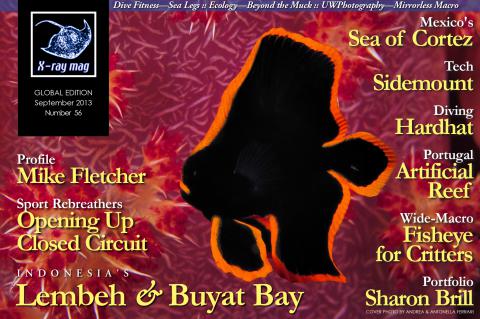Lembeh Strait: Critter Central
The world’s full of triangles. There’s the Love Triangle, the Golden Triangle, the Bermuda Triangle… and then of course, most relevant of all to us divers, there’s the Macrolife Triangle, that blissful figure made up by the Malaysian islands of Lankayan and Kapalai and—at the northern tip of the Indonesian island of Sulawesi—the Strait of Lembeh.
Everybody today knows about muck diving—the concept of looking for strange and grotesque macro critters in coral-poor areas with medium or downright bad viz—but not everybody knows this is where it all began, circa 15 years ago.
A young American diver and entrepreneur just happened to discover the then-unknown place—a sea channel less than 40 meters at its deepest and less than one mile at its widest, leading from the harbor town of Bitung to the open sea on the eastern coast of Northern Sulawesi—at the same time falling in love with a plantation set in an idyllic little bay between a rugged, jungle-covered rocky slope at its back and the black volcanic sand beach on its front. Ditto, the legendary Kungkungan Bay Resort (KBR) was born!
It soon became a famed destination all over the world for unusual, spectacular species, especially for those in the most affluent areas of the United States—but the catch was in its very high price policy, which put it outside the range of common mortals.
Now, luckily for both the crowds of point-and-shoot users and the more professional DSLR underwater photographers, a new price policy put in place has given KBR a new lease of life. People are flocking to the place and its lovely bungalows by the sea, and a beautiful swimming pool has been added to the grounds.
With several more top level dive resorts now springing up close by and the Lembeh Strait soon to be declared a Marine National Park by the Indonesian authorities, the future of this very special dive destination seems at last truly assured.
A unique location
What is so special about the place? Well, everything. KBR, being the first dive resort, was able to pick the best location, and its setting is truly idyllic. The surrounding panorama above water is simply enchanting, with steep, rocky slopes covered in thick greenery, sea eagles soaring above and colorful local fishing boats passing by.
But it’s the diving which makes Lembeh so unique. Being close to a very deep water area featuring daily cold-water upswellings, the sandy and silty sea bottoms of the Strait of Lembeh host an enormous variety of rare species, which are common here but almost unheard of eveywhere else.
Even common species here come in dazzling and unique color phases, this fact being due both to the dark volcanic sand on which they live and some other undiscovered factor. The weird, the grotesque, the rare and the downright absurd are a daily occurence at its dive sites.
This is a destination where it’s not uncommon to find holy grails like weedy and paddle-flap rhinopias, Ambon scorpionfish, mimic octopus and wonderpus, pygmy seahorses, blue-ring octopus, hairy octopus, flamboyant cuttlefish, boxer crab and tiny orange-rimmed baby batfish on a daily or weekly basis—it’s a place where after a few days, it’s easy to become so spoilt that you’ll just give a passing glance and no more to uncommon species like painted and clown frogfish, thorny seahorse, cockatoo waspfish or mandarinfish.
But that is not all, as the Lembeh Strait, which has become so famous for its world-class muck diving, offers in fact first-rate coral reef dives on quite a few spots, such as Angel’s Window or California Dreaming. We know. We’ve been able to photograph there some very rare species of butterflyfish and wrasse we’d never seen anywhere else!
In any case, and whatever you’re looking for (well, except for big sharks—but in fact we have seen large eagle rays there!) the Lembeh Strait offers unsurpassed photographic opportunities.
(...)
Download the full article ⬇︎

Originally published
X-Ray Mag #56
Diving Indonesia's Lembeh Strait and Buyat Bay; Mexico's Sea of Cortez; Portugal's artificial reef; Sidemount diving; Hardhat diving; Opening up closed circuit; Interview with Mike Fletcher; Beyond the muck ecology; Sea legs for dive fitness; Wide-macro fisheye photography for critters; Mirrorless macro underwater photography; Sharon Brill portfolio; Plus news and discoveries, equipment and training news, books and media, underwater photo and video equipment, turtle news, shark tales, whale tales and much more...































